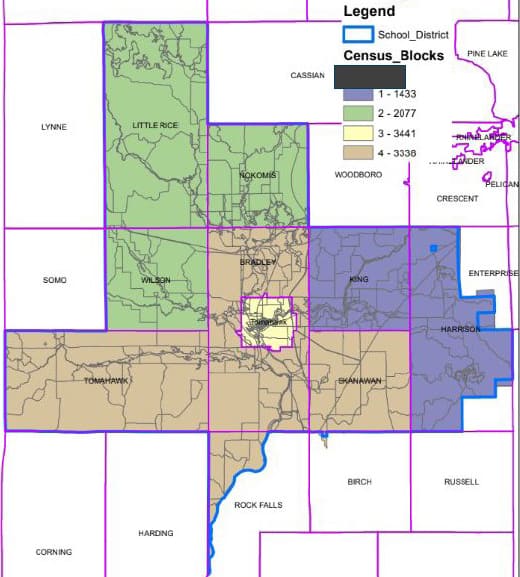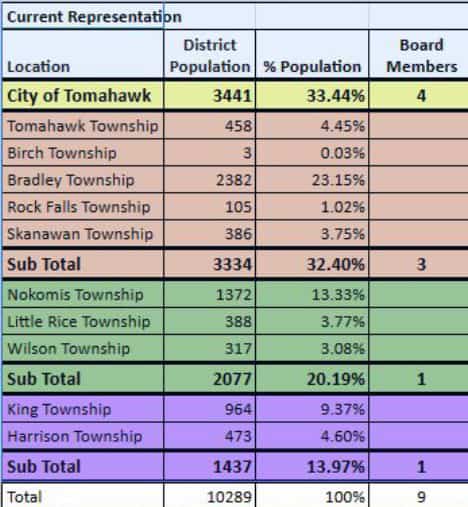Presentation highlights population changes, proposes several composition models
By Jalen Maki
Tomahawk Leader Editor
TOMAHAWK – A special committee is looking into rebalancing representation on the School District of Tomahawk Board of Education.
Since Aug. 2023, the Reapportionment Subcommittee, made up of board members Kay Kissinger Wolf, Shar Kirsch and Dave Long; Lincoln County Clerk Chris Marlowe; and community members Marguerite Lyskawa, Ken Schulz and Jon Long, has been exploring ways to alter how the board is composed to better reflect the district’s population distribution.
Current board composition
The district includes the City of Tomahawk and several townships in Lincoln and Oneida Counties.
Currently, the board utilizes a “4-3-1-1” representation model. Under this model, the board is composed of a total of nine members representing four designated areas within the district for three-year terms.
Four members represent the City of Tomahawk; three represent the apportioned area covering the Towns of Birch, Bradley, Rock Falls, Skanawan and Tomahawk; one represents the apportioned area that includes the Towns of Little Rice, Nokomis and Wilson; and one represents the apportioned area encompassing the Towns of Harrison and King.
These areas of representation have been in place since April 1972.
All registered voters in the district may vote for board members, no matter where they live, but candidates must reside in their apportioned area. For example, a Town of Birch resident may vote for a candidate seeking to represent the City of Tomahawk, but that candidate must reside in the city.

Why reapportionment is being considered
In a presentation provided during the board’s January meeting, the committee explained that reapportionment is being considered due to population shifts within the district over the last several decades.
According to the presentation, which cites U.S. Census data, the City of Tomahawk went from having 49% of the district’s population down to 33.1% between 1960 and 2020, yet the area continues to be represented by four board members.
Meanwhile, two of the three district’s rural apportioned areas have seen population increases over that time while still having less board representation than the City of Tomahawk has.
From 1960 to 2020, the area encompassing the Towns of Birch, Bradley, Rock Falls, Skanawan and Tomahawk saw a 3% jump in percentage of district population, from 30.7% to 33.7%, the presentation said.
The percentage of district population in the area covering the Towns of Little Rice, Nokomis and Wilson increased from 7.5% to 20.8% in that time.
Despite these increases, each area is represented by one board member.
The area including the Towns of Harrison and King, which also has one representative on the board, saw a slight decrease in percentage of district population over the same time period, dropping from 12.8% to 12.4%.

Committee goals
In exploring reapportionment, the committee said it has several goals.
The committee said it will look into models that ensure equitable representation based on population, equitable opportunities for election and simplicity, as well as voting district continuity, which is required by state statute.
The committee recommended that a process of apportionment be codified. Under this proposal, the board would reexamine apportionment every ten years, with this process required to be completed within three years of the census.
‘3-3-3’ model backed by committee
The committee presented five potential options for reapportionment, with a “3-3-3” model ultimately being supported by the committee.
Under a 3-3-3 proposal, the district would be made up of three apportioned areas, with three representatives from each area. In each election cycle, one seat from each area would be up for election, allowing for residents in each apportioned area to run for a three-year term in each election year.
A 3-3-3 plan would also keep the board at its current nine-person membership.
The committee said this model “offers consistency” and “encourages equitable representation and involvement based on population.”
Under the two 3-3-3 plans proposed by the committee, the percentage of district population in each apportioned area would be roughly between 32% and 34%.
Next steps
Moving forward, the committee said it aims to send its work for legal review soon, and the committee has reached out to local municipalities offering to share its information during upcoming public meetings.
The committee is also looking to give community members the opportunity to review its work during springtime public meetings. The feedback gathered by the committee will be used to reevaluate its plans before making a final recommendation to the board in the summer.
The committee’s final reapportionment proposal will be presented to the board during its Annual Meeting in September, according to the committee. The plan would then be voted on by the board.
